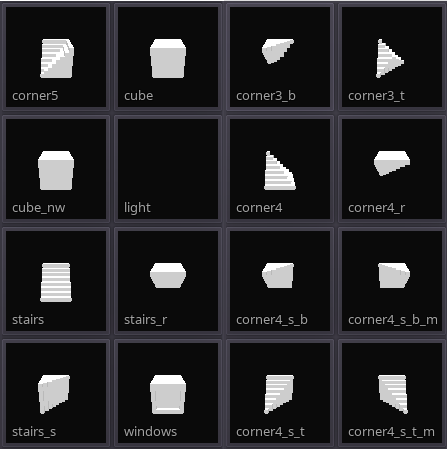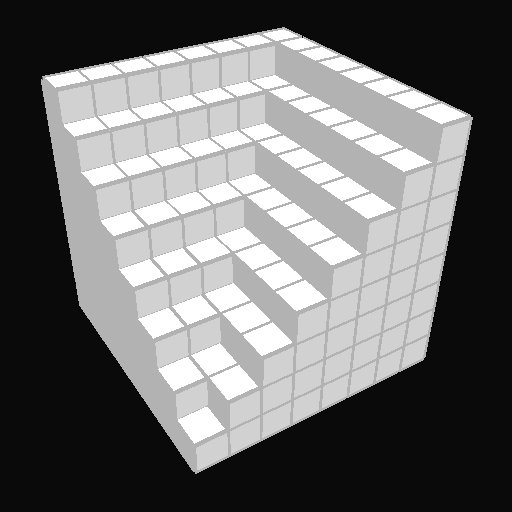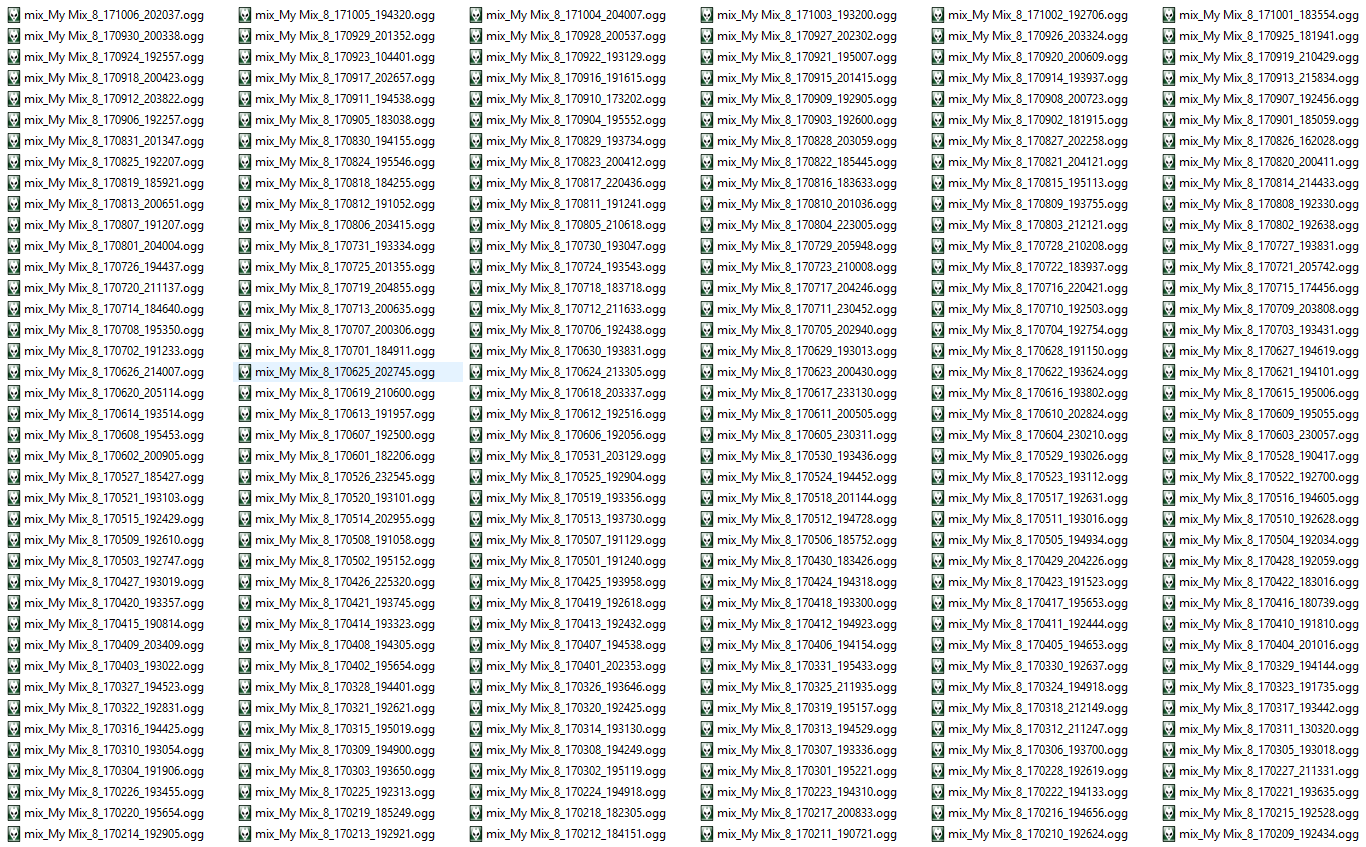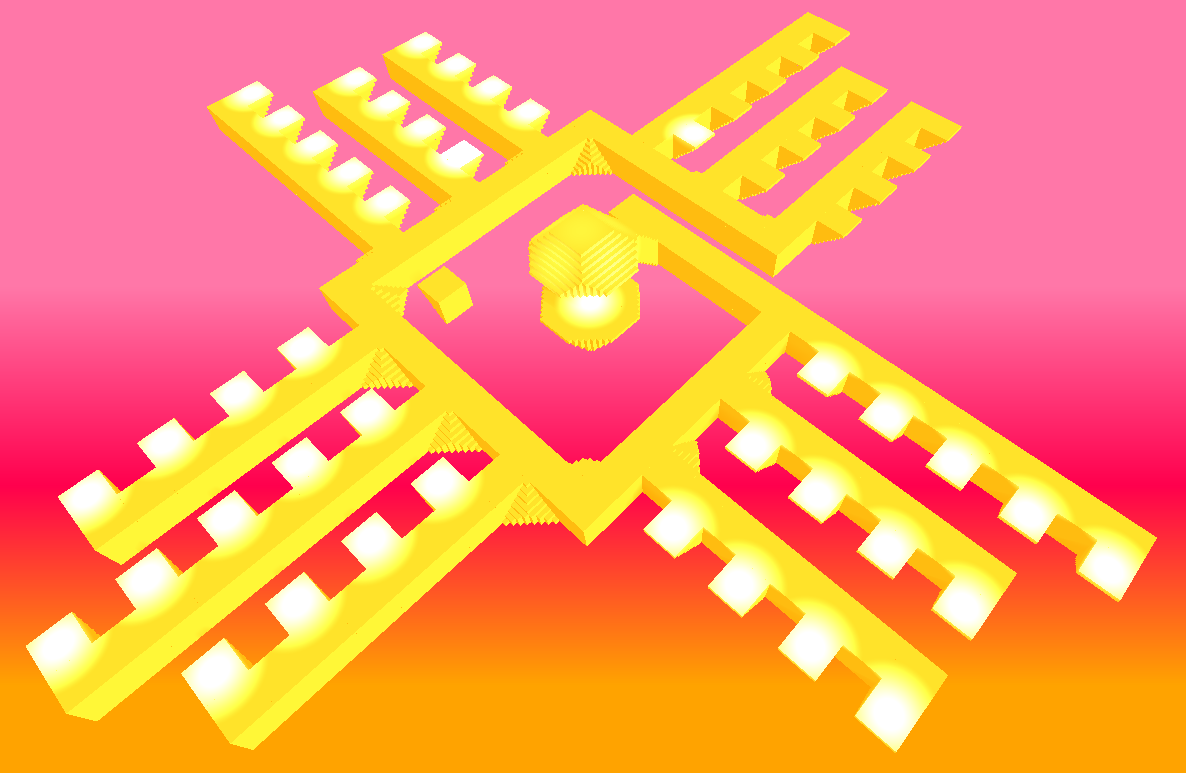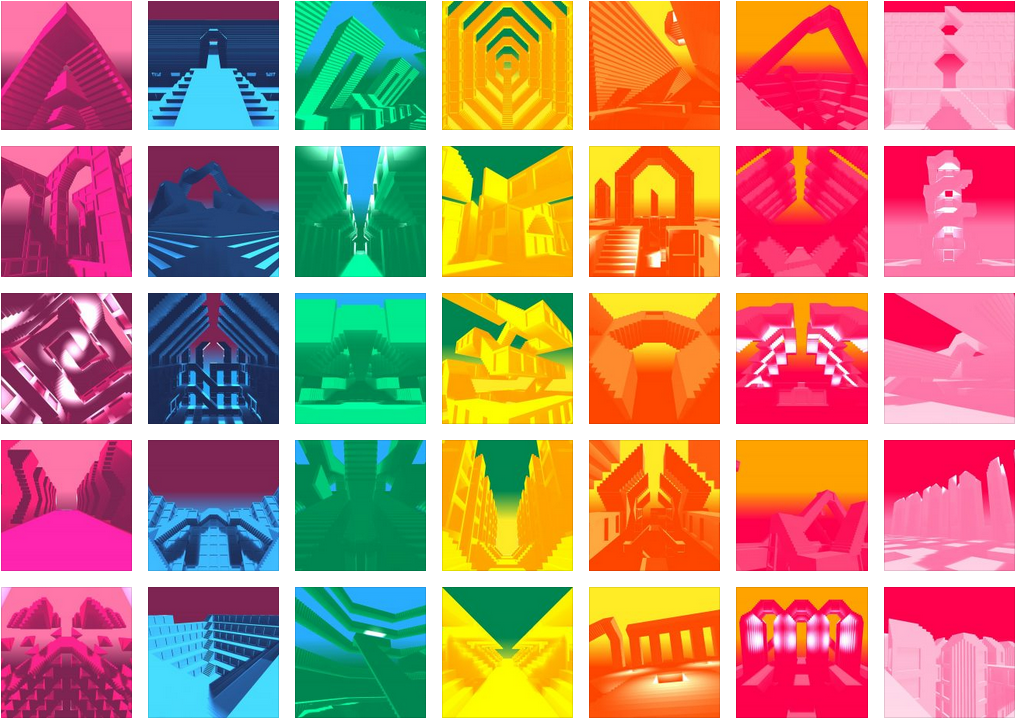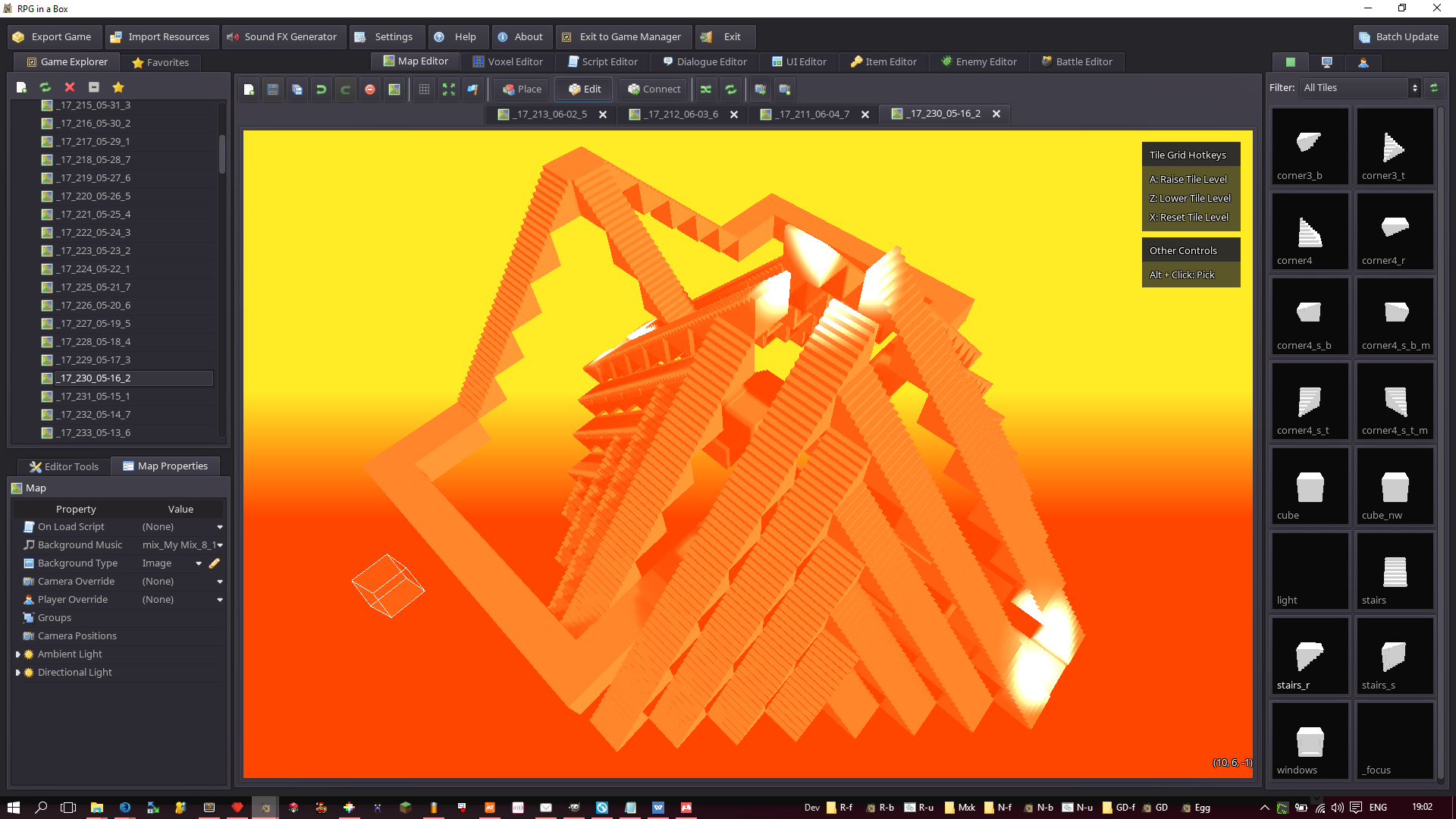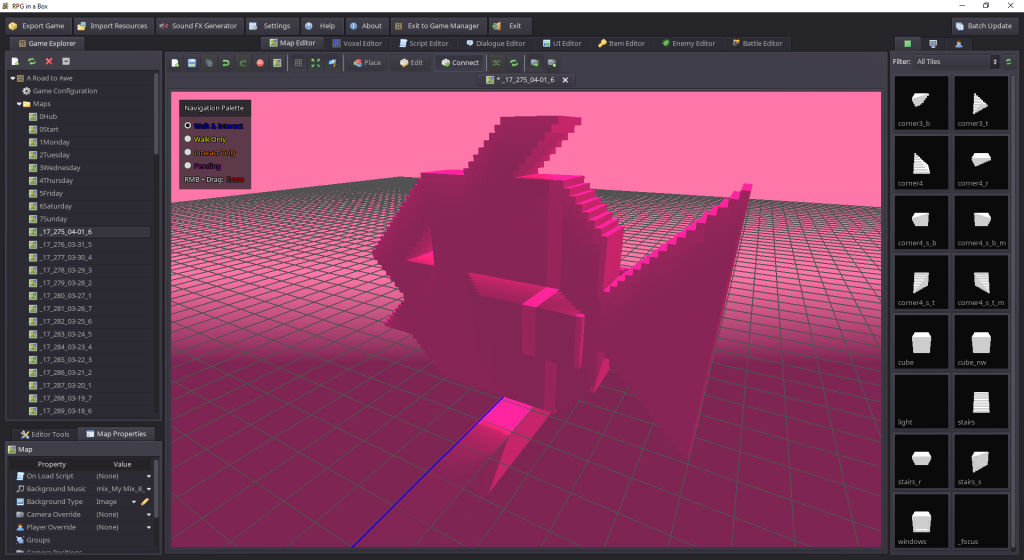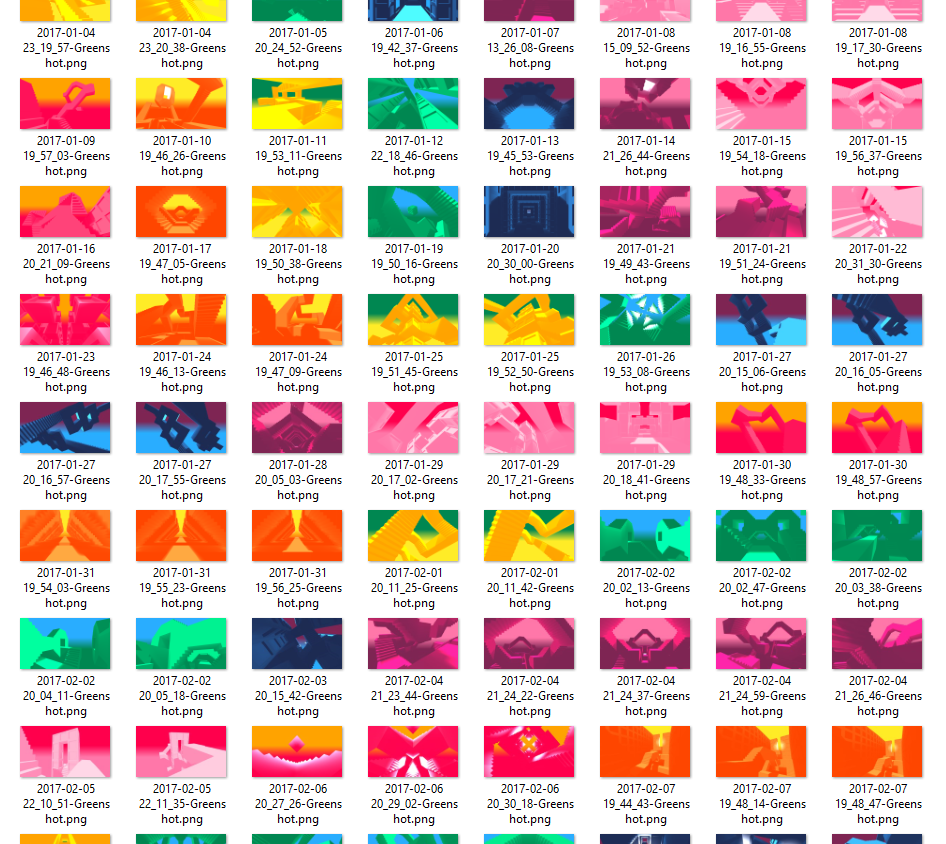There is no end
Yes, I know, I’m very late. One year late, in fact. Does it matter, though?
This project has ended, and yet, it continues. It was the point all along: to make use of cycles. The development has stopped, the days on the calendar have been checked, the daily updates have vanished with 2017, and the whole experience seems even more distant at the end of 2018. But the result is still here, as a digital artifact, as a playable abstract portion of my life, and as a blur of my own memories.
While very personal, the game doesn’t need me to keep existing. It now lives in the minds and hearts of everyone who has played it, no matter how tiny the space it occupies. It needed me to be complete, but only to validate its own concept. Would it be a failure if I had missed one day, or if I had given up? Would it still have any value? How many days in a row would have made it a success? Half a year? More? Less? Did the whole game actually need to be developed to be relevant, or was its concept enough?
Sooner or later, working with time leads to absurdity. Roman Opalka carried on until the end, at 79. Had he died earlier, would his work be less meaningful? How meaningful is it now?
Opalka counted from 1 to 5,607,249 over a period of 46 years. He painted each number in white on black, and added 1% more white to the background with each new painting. He didn’t reach his objective of 7,777,777, where he would have painted with white on white. But he sure proved an incredible commitment to his art, literally turning his lifespan, and more than that, his whole life, into his medium. I only counted from 1 to 365, for only one year.
I think A Road to Awe has proven itself as a conceptual work of art more than a game. Sure, it can be categorized as a walking simulator, which apparently means anything using a first person perspective without relying on mass murder as its core mechanics. But I don’t know if it’s a good walking simulator. One year later, I still haven’t played it from start to end in a straight session. I know many levels are bland and uninspired, while a few others are genuinely interesting. It’s quite a good metaphor for daily life, or at least, for my life as a creative person.
At the beginning of 2017, Owen Ketillson mentioned in this piece that the game doesn’t really function like a diary. It wasn’t obvious yet that each day of the week had its specific color. And the (kind of) secret hub to jump between weeks was still to be discovered. So yes, the game is inscribed in time, once you know what to look for. You can actually browse what my mind produced every day of 2017. But I agree the level of abstraction doesn’t really do justice to the expected intimate nature of a diary. Very few levels are visually meaningful in the sense you can actually decrypt facts, thoughts or feelings.
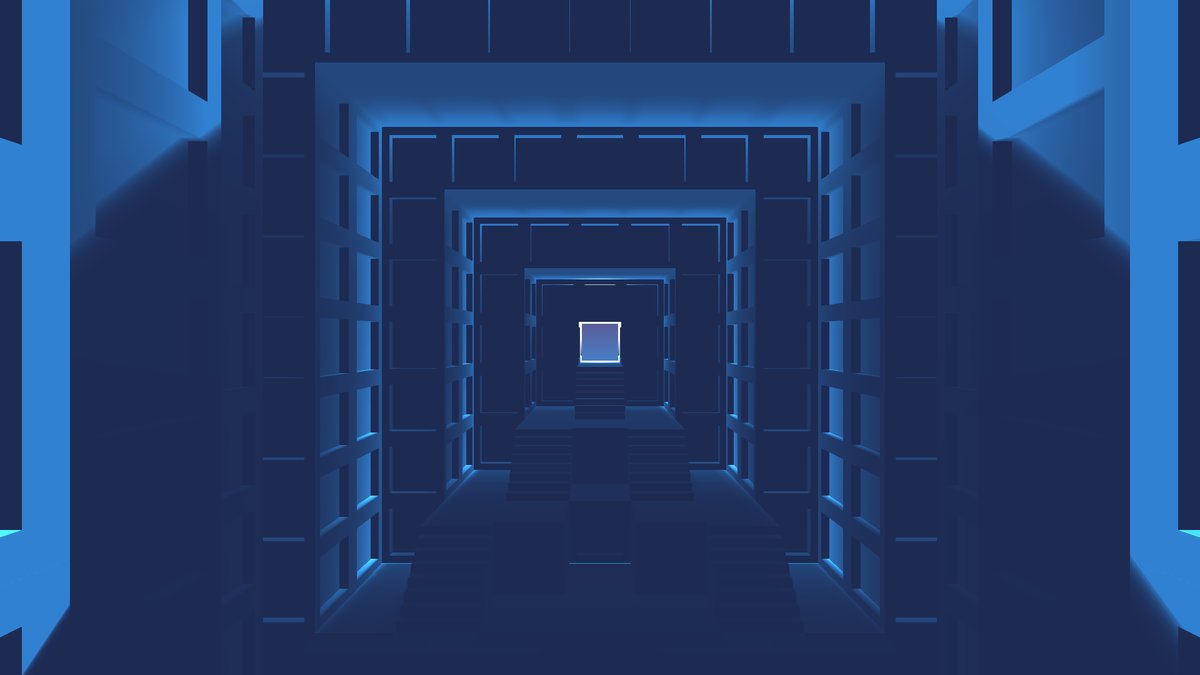
This one was made the day Donald Trump became president of the USA. Kind of fitting, I suppose.
The mechanical part of the concept overrides the possible meanings of individual levels. It blends them within time and space constraints and negates their unique features. Sure, some stand out. But many look very similar, especially when you didn’t build them. This being said, 3D spaces bathed in the joyful PICO-8 palette still have more personality than numbers painted on a fading background. Brutally bright colors, and yes, even the dreadful Wednesday Yellow, probably helped me carrying on with the project. Building black and white only structures for one year would probably have been depressing.
I wonder what sense of humor Roman Opalka had.
What went right
The engine
This project would never have been possible without two amazing tools: RPG in a Box, the engine I’ve used to create the game, and Itch, the website that allowed me to distribute and update it daily.
RPG in a Box was kind of a wild bet, since the engine was, and still is, in alpha stage. Would using it for something very different from its original purpose be a problem? Would the engine handle 365 levels? Would it still be around in one year? Knowing the dedication and reactivity of Justin Arnold, its developer, I was certain of my choice, and it turned out great. Justin even added some pretty cool features along the way, including one-click export to Windows, macOS and Linux, gamepad support, smooth stairs movement and other rad stuff.
On the other hand, this project was designed with RPG in a Box in mind. Its voxel-based nature and its ease of use were major criteria. With only 15 minutes a day to make a level (at least when the project started, ahem…) my workflow had to be very fast. Having followed its development closely since one year for Nékromegà, I knew how to use it, and even if I hadn’t, I think it would still be the best choice for this project. Once my base blocks and scripts and settings were ready, all I had to do was to stick to my plan. Big props to Justin for his fantastic software!
The distribution platform
Now, if I can say the project was designed to be made with RPG in a Box, I can also say it was designed to be distributed with Itch’s Refinery. With my awful internet connection, it would have been a huge pain to upload an ever-growing archive every day from scratch, since every level added about 1 Mo to the total. And every player would have had to download the entire game every day. With the Butler app, all I had to do was to set up a tiny batch script and click my shortcut to upload and update the game. There’s been a few issues, slight delays, and one major fuck up due to me messing with a dual boot setup on my machine (I wasn’t idiot enough to not make backups, though), but overall it worked flawlessly.
Press, YouTubers and players
I was very lucky to attract several nice people who took interest in the game right from the start. YouTuber Petjeh decided to play it every month while talking about what mattered to him. To see my “diary” being actually used as a diary by someone else, even if it was in a loose sense, kind of blew my mind. His first video ended up as the game’s trailer on Itch. He lost interest after six months, and dedicated his channel to the AAA multiplayer action fighting game For Honor, but it was a huge motivation factor. The account where he started his A Road to Awe videos has been closed since, but you can still watch the last of them here, here and here.
Here’s a neat video by SirTapTap.
A few others joined along, though not with regular updates, but it was fantastic to see that such an experimental game could have an audience nonetheless. I didn’t expect this at all.
Another important event that probably drove YouTubers to the game in the first place was a PC Gamer “Game of the week” feature right at the beginning of the project. Almost two years later, I still get traffic from this article, even if it’s now drown under months of weekly updates. Other articles popped here and there (yes, I should update this page.) Last but not least, the game has been featured on Kotaku in early January 2018, which provided a huge boost in visibility. I had totally forgotten I had answered a call for indie games submissions from the author on Twitter. Oddly enough, I noticed this sudden peak while waiting at the hospital for the birth of my son, randomly browsing my phone during this incredible night.
Timing-wise, it was absolutely perfect to become a parent a few days after the project ended. What if the baby had been born in 2017? Well, the project would have been delayed, of course. A lot. Creating an actual human being is so much more important than building abstract voxel structures that it wouldn’t have mattered at all. But everything went according to the plan. Retrospectively, a Road to Awe feels a bit like a countdown to parenthood. One last big silly project before getting serious. Or maybe not serious at all, maybe, in fact, a lot less serious, because earning a smile from your toddler requires other skills than game development, and feels much more rewarding. But that’s another story…
In December, as a side effect of the pressure to soon have to manage my time much more efficiently, I started to work on a Twine-based time tracker. Yes, you read that well. I ended up forgetting about every time-tracking tool I ever tried (including the one I used for A Road to Awe during the first months). So I though, hey, why not develop my own with my very limited coding skills? And to my surprise, I came up with a rather satisfying result. It was really refreshing to work on an actual tool, with a rather different mindset compared to game design. I honed my JavaScript a bit on this one for sure. Ironically enough, after a few weeks, I forgot about it (but a successor might appear in the next few months…)
One last thing to mention regarding what went right: some lovely people made donations. I earned about 40€. Which is, now I think about it, a lot. Most of the donations occurred at the very beginning and at the very end of the project, thanks to PC Gamer and Kotaku coverage. Maybe doing this for a few decades would earn me a living?
What went wrong
Time management
There is an old saying in video game development about project planning:
Any task will take at least twice the time you were expecting.
I’ve experienced this a lot. Unsurprisingly, it turned out to be true once again. I had planned to spend 15 minutes a day for building the Road to Awe. Slowly but surely, I ended up working on it 1 hour a day, and even more. The idea was to spend 10 minutes creating the level then 5 minutes uploading it and posting a screenshot on Twitter. But this estimation didn’t take a few things in account:
- Working on level design for only 10 minutes was fun in the beginning. But weeks after weeks, it became both frustrating and stressful. I had to take it easy to keep enjoying the experience, so I dumped the timer.
- On the other hand, this also meant I could now waste a lot of time being a hopeless perfectionist, tweaking every little detail, sometimes even remaking a whole level I wasn’t satisfied with. I still hate 90% of them, by the way.
- Posting images on social media took much more time than expected, for a simple reason: I had to take a decent screenshot before sharing it. Finding the right spot and the right angle was almost as time-consuming than building the level itself.
- I hadn’t planned to write any travelogue at all. I still did, and while these blog posts weren’t especially deep or lengthy, they took time. Day after day, month after month, nibbling on my already limited time.
All of this time wasting could have been easily avoided if I were a bot, and did everything mechanically without any afterthought, but sadly, I’m a human being. Why not train a neural network to build levels and update everything in my place? Because I lack the technical skills. And also, of course, because I’ve learned to enjoy the needless artistic suffering.
Symmetry
I have mixed feelings about symmetry. From a level building perspective, I love it. Symmetry allowed me to build complex structures rather quickly, since in many cases, I only had to think about one half of the level, or even one quarter, then to mirror it to create the rest. Even if it still was a manual process, it was much faster that building more organic or realistic structures. It became a kind of mental automation that could even be relaxing.
I think this symmetry-as-a-shortcut approach allowed me to output voxels on demand, like an algorithm I’d use to hide my lack of creativity. It was probably the smart thing to do given the time constraints, but I can’t help thinking it was a bit like cheating. And it wasn’t always visually pleasing, far from it. On the other hand, it’s still more creative than incrementing an absurdly big number (sorry, Roman). Maybe I should have defined a no-symmetry rule. But then, maybe many levels would have been worse, or wouldn’t exist at all.
The Maze of Stairs to Awe
This was supposed to be a road, but for most parts, it’s just a terrible brutalist mess of colorful floating stairs. Before I started working on the project, I had this mental picture of a small road meandering between trees, in a somewhat organic way. I never managed to build it. I didn’t even get close to it. Yes, it was an unrealistic goal to aim for, especially with low-resolution cubic assets… Though it wasn’t really a goal, more some kind of vision. It still haunts me, so I guess I’ll have to do it justice in a future project.
It still feels incomplete
One year after this project’s completion, even if I’m relieved it has ended, I’m also strangely frustrated. The road is still being built in my own mental space. There are many things I would rebuild entirely, colors I would change, music I would regenerate, rules I would rewrite. But I suppose it would betray the original purpose of the project, which was to turn the past into something playable.
I had to bear with unexpected road building withdrawal. For a while in early 2018 I posted some tiny pixel art on Twitter with the #lectropix hashtag. It was so strange to not create something new every day that I kept going on, but with a smaller, less time-consuming scale. It also used the PICO-8 palette, but with a 48×16 resolution, and no specific theme or constraint.
And yes, I’m itching to launch a new daily updated project. Maybe in a few years…
William Basinski hasn’t played it yet
A few months after starting the project, I ended up buying a couple of albums on Basinski’s website, and he sent me a thank you email from some personal Yahoo address. At first I thought it was spam, but no… It seems he sometimes does this, which is freaking awesome. It was very short, and it blew my mind. I’m a big fan of his work, and he’s been a real inspiration over the years. So I though, why not say hi and tell him about A Road to Awe, since it deals with the passing of time, the core theme of his work? And he answered! “Please send me the link.” So I did, but he didn’t answer, and I didn’t insist.
I doubt he’d find it very interesting, since A Road to Awe is visually and musically rather crude and pretty far from his aesthetics, but I still find amazing he showed a bit of interested. I plan to keep buying more albums and remind him I’m waiting for his feedback if he thanks me again (insert evil/distressed laugh here).
What I’ve learned
If this project has taught me anything, it is that discipline and stubbornness can do wonders when you write down your goals and stick to your plan. Imagination, expertise, technical prowess, even motivation come second when you’ve clearly defined your creative process and its inherent constraints, and are ready to follow your fixed path.
I knew precisely what to do, when, and for how long. Yes, it sounds dull, and sometimes it was. But it also was the first time any of my projects went so smoothly. I never envisaged it as something carefully planned, especially since I was in a hurry during the last couple of weeks of 2016 to set up everything when I got the idea. And yet, the few simple rules I elaborated back then ensured the success of a level design marathon that took epic proportions.
It was a stupidly ambitious project that seemed much smaller than it actually was, like most of my projects. But unlike most of my projects, I finished it. All steps were planned as the identical parts of a linear system. Had I missed one day, the road section would have been replaced by its default state, a simple straight line, and I would have carried on the next day, or the next. Unless I died.
Of course, this kind of planning could only be applied to a fully time-based project. In fact, the planning and the project became the exact same thing. But it worked.
Now I know my next projects will have to be planned in a similar fashion. Break everything down into simple, independent tasks. Yes, it’s very hard to do, especially with video games, which are usually made of awfully interdependent and complex systems. That’s why I’ll also have to be smart with my game design. Think modular, iterate, rinse and repeat, but only within tiny time frames.
That’s also why my first goal for 2019 will be to resume the development of a time management tool that will allow me to use my limited time more efficiently. And by “tool”, more than a software, I mean a mindset.
The future
Will the Road get some updates? Probably at least one, with the upcoming RPG in a Box 0.5 release, since this version will offer numerous improvements. I don’t think, however, it will be a direct update of the current build, but mostly a separate edition with a bit more polish and quality of life tweaks. Because of the very minimalist way everything is set up, the slightest change might turn the whole visual experience into something very different. I want to keep the 2017 original edition in its current state, with all its flaws and imperfections.
I initially had plans to release some kind of soundtrack, but at this point, I don’t know how nor when it will happen. I have about 400 loops to put into order. More than 3 hours of procedural music, most of it sounding like cheap ambient garbage, but with the possibility of being used as raw material for something much more elaborate. Maybe I’ll start another daily semi-automated process to remix these loops, maybe I’ll hand-pick a few of them and try to make an actual album, maybe I’ll put together a giant mix of everything… I don’t know yet. It sounds like a good excuse to experiment a bit more with ORCΛ. Ideally, I’d love to do Weekly Beats, but I know I won’t have enough time.
I have numerous other projects made with RPG in a Box to work on, Nékromegà and Phalanstery being the ones I’m especially eager to finish. I’m also toying with the concept of a rule-free game that would work similarly to A Road to Awe, but with absolutely no constraint except updating it as often as possible. Chaining little worlds and voxel experiments together, see which recurring patterns emerge, explore something more intimate, maybe a bit autobiographical. But it’s just an idea at this point. I doubt it will become anything else before a few years.
Beside the road, there is Opuscule, the writing tool and mini-website generator I managed to develop with Godot in 2018. It has become something I use almost every day for my own needs, and that I also work on every day. In a way, it has replaced A Road to Awe in my daily routine.
And, of course, I have another shiny new game idea which has been slowly taking more and more of my mental space over the last few months, involving glyphs, vectors, roguelike and card-based mechanics, but shhh… I’m forcing myself to postpone it for now.
But for how long?
You can still explore the road here:

